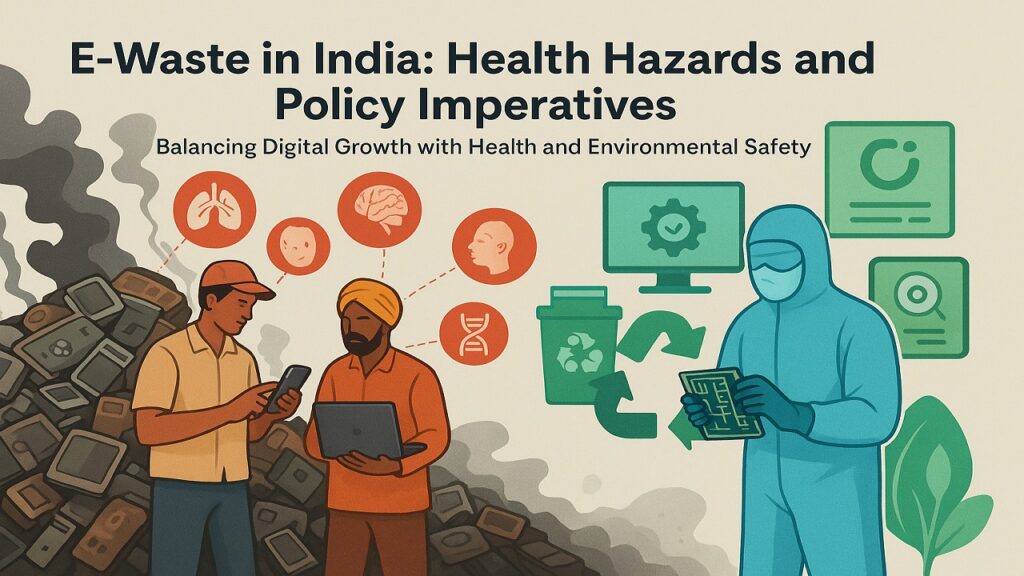
Context
- India has witnessed a rapid digital transformation, increasing dependence on electronic devices.
- Consequently, e-waste generation has surged, creating serious environmental and public health challenges.
- In 2025, India generated 2.2 million tonnes (MT) of e-waste, becoming the third-largest e-waste generator globally, after China and the United States.
- Despite having formal recycling capacity, more than 50% of e-waste is still handled informally by scrap dealers and kabadiwalas, exposing workers and communities to serious health hazards.
Body
India’s E-Waste Burden
- 150% increase in e-waste since 2017–18, from 0.71 MT to 2.2 MT in 2025.
- 65 cities contribute 60% of total e-waste, including hotspots like Seelampur (Delhi), Moradabad (U.P.), and Bhiwandi (Maharashtra).
- 322 formal recycling units exist with an annual capacity of 2.2 MT, yet over half of e-waste remains in informal chains.
Health Hazards of E-Waste
1. Respiratory Illnesses
- Open-air burning and acid treatment release fine particulate matter.
- 2025 MDPI study: 76–80% of informal e-waste workers suffered from chronic bronchitis and asthma.
2. Neurological Damage
- Exposure to heavy metals (lead, mercury, cadmium) affects brain development in children.
- 2023 Frontiers in Public Health review: blood lead levels ≥5 µg/dL linked to cognitive decline and behavioral disorders.
3. Skin and Ocular Disorders
- Direct contact with e-waste causes rashes, burns, dermatitis, and eye irritation.
- 2024 review: up to 100% of informal recyclers in certain clusters experienced skin problems.
4. Genetic and Systemic Impacts
- Long-term exposure results in DNA damage, oxidative stress, and endocrine disruption.
- WHO report: 18 million children globally live or work in e-waste zones, many in India.
5. Syndemic Effects
- Health risks are compounded by poverty, malnutrition, and poor housing, disproportionately affecting the urban poor.
- Informal recycling hubs report higher rates of miscarriages and preterm births (similar trends observed in Guiyu, China).
Policy Response
- Strengthened EPR Norms (2022 Rules): Producers are responsible for collection and recycling of e-waste.
- Mandatory Registration: Dismantlers and recyclers must register to curb unsafe and illegal practices.
- Incentives for Formalisation: Policies encourage transition from informal to formal recycling units with compliance-linked benefits.
- Persistent Gaps: Only 43% of e-waste was formally processed in 2023–24; disputes over EPR credit caps hinder enforcement.
Way Forward
- Formalise Informal Sector: Train kabadiwalas, provide PPE, healthcare, and social security, protecting livelihoods while enforcing safe recycling.
- Strengthen Enforcement: Implement digital tracking, periodic audits, and empower Pollution Control Boards to act against unsafe units.
- Medical Surveillance: Organise regular health camps, baseline studies, and long-term monitoring in e-waste hotspots.
- Promote Innovation: Support R&D for affordable, local recycling technologies and decentralised recycling hubs to reduce transport costs and increase efficiency.
- Awareness Building: Integrate e-waste education in school curricula and conduct public campaigns to promote responsible disposal.
Conclusion
- India’s digital progress cannot come at the cost of human health and environmental safety.
- Systemic reforms combining science, justice, and innovation are essential to protect workers, children, and ecosystems.
- Only through safe, inclusive, and sustainable e-waste management can digital empowerment contribute to equitable and resilient growth.
Source : The Hindu
